Theater might be the most exclusive of all performance arts, with the possible exception of ballet. Tickets cost money, yes, and that’s one barrier to access, but more important is location. Even if you can afford a ticket, you’ll need to travel to a theater mecca like New York or London, watch for a touring company to swing by the nearest large city, or wait for the rights to die out so your community theater can put it on. I know young girls who grew up belting the Wicked soundtrack but had to wait a decade before it came on tour to their city. A long-in-coming, face-to-face encounter with your favorite musical can make you part of the magic.
But television brings the magic right to the living room.
The Princess and the Pea is an odd fairy tale to adapt. The ridiculousness of a princess being able to feel a pea under a mattress mountain is difficult to work into a plotline, though it brings with it enormous potential for comedy. The musical Once Upon A Mattress already had a Broadway run of a few years under its belt when it first hit the small screen with a black-and-white adaptation in 1964. The ninety-minute running time constraints of television called for some trimming. Several songs and scenes got the ax. So did a major plotline. Sir Harry was supposed to impregnate his girlfriend, Lady Larken, out of wedlock. But in the early sixties, this was a bit much for public sensibilities. Married couples sharing a bed was still a novelty, albeit one that was gaining ground. The beautiful witch Samantha Stephens shared a bed with her mortal husband Darrin when Bewitched premiered this same year. Harry and Larken’s subplot was downgraded to an elopement.

Television is more intrusive than theater. Theatrical audiences have to very intentionally purchase a ticket and make their way to the show, so they usually have some foreknowledge of the plot. Casual viewers who stumble into the plot as they flip on the television might be scandalized.
To some extent, fans can experience a musical via soundtrack, and that’s how they fall in love with the show in the first place, working up the desire to shell out the money to see it when an opportunity finally presents itself. But a good chunk of story is told through motion. Once Upon A Mattress’s King Sextimus is cursed with muteness and can only communicate in pantomime (because apparently this nation’s ruler can’t read or write). A soundtrack-based audience can’t experience his character at all without a visual. His curse becomes problematic when his son, the oh so sheltered Prince Dauntless, asks old dad what a wedding night is all about.
This is left out of the 1964 portrayal, but when the musical was broadcast again in color in 1972, King Sextiumus gives his son “the talk” by acting out a bumbling pantomime of flowers, seeds, bees, and storks, which Prince Dauntless somehow manages to understand. This brought remote audiences’ attention to a major comic element of the story for the first time. The pantomime king looks ridiculous, fluttering his hands behind his back to make bee’s wings and stomping on imaginary flowers in his oversized, pointy shoes.
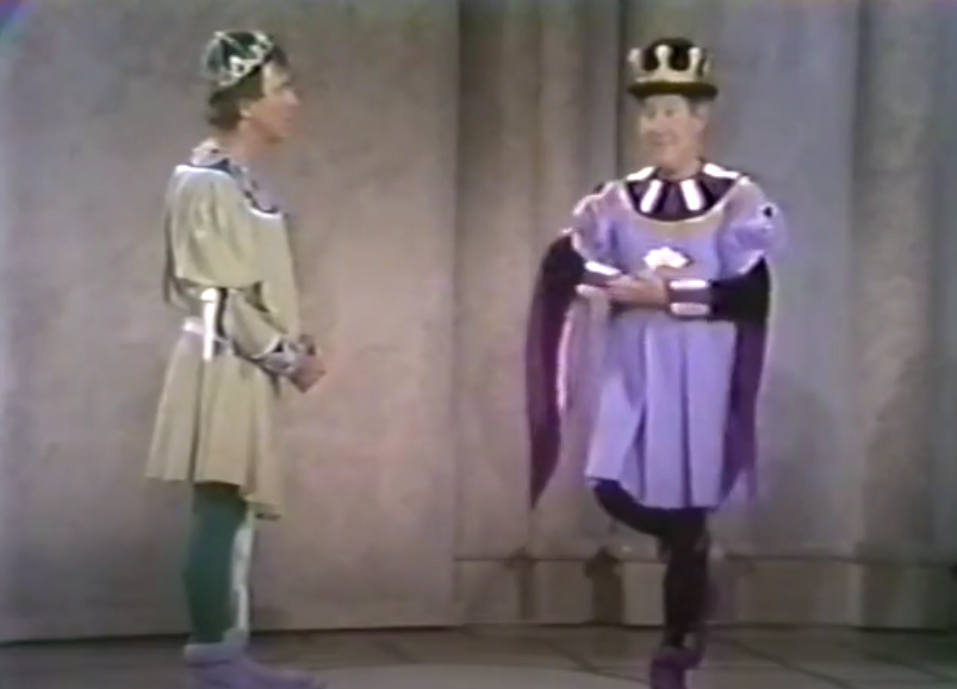
Stage productions are recast, reset, and recostumed to match changing trends, but televised musicals remain crystallized in time. For that and other reasons, TV musicals give off a cheesy vibe if you view them decades out from the original air date. Proximity is a factor as well. Props and costumes designed to be eye-catching from the back row may look flamboyantly silly when viewed from across your living room.
The 1992 production The Trial of Red Riding Hood is not only a musical but a musical on ice, another art people usually want to experience in person. The plot follows the teenaged Red’s arrest and trial for the murder of the Wolf. Elements of criminal celebrity familiar to the television age are included throughout. Gossipy villagers anticipate watching Red take the stand in what they term “the trial of the century.” Her arrival in town is heralded by a skating marching band and the townsfolk announce her as “the star of the show.” Prior to running into the Wolf, Red meets The Boy Who Cried Wolf in the woods. When she doesn’t recognize him on sight, he brags that he was “in all the papers” for his lying escapades.
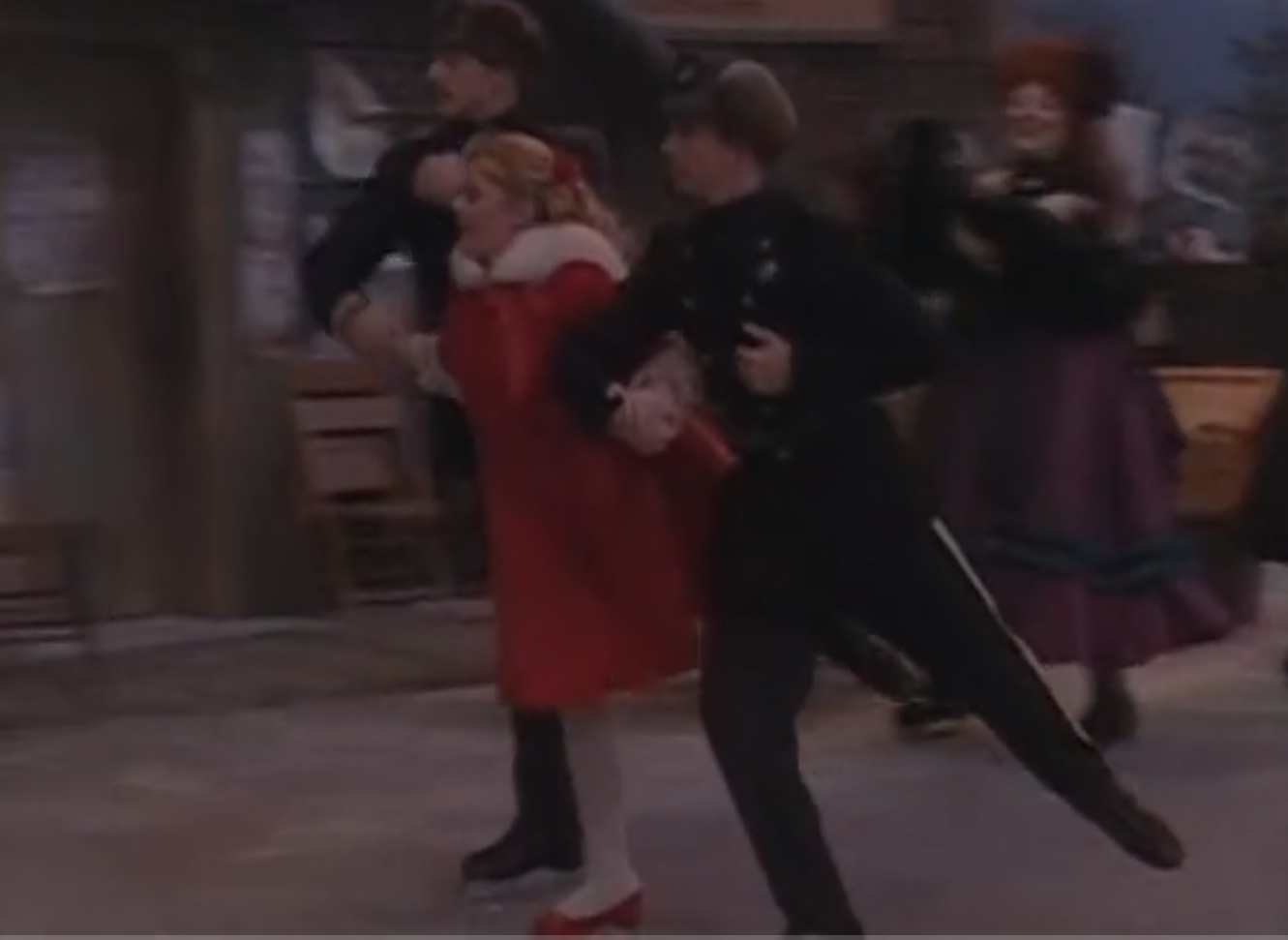
Props and costumes need to be adjusted to accommodate a slippery floor, giving the production a more “staged” look than a traditional televised environment. Even when the camera hits characters in such a way that their feet aren’t in the shot, you can never forget that they’re gliding instead of walking. This motion wouldn’t feel out of place if you were watching it in an ice rink, but it feels out of place at home, lending the entire production a cheesy feel.
Theater is a fanciful world where audiences dutifully suspend their disbelief and let imagination turn an unmoving wooden block into a horse drawn carriage, should the need arise. Viewers file into the theater with the understanding that live special effects can only do so much to magically transform a man into a beast and Peter Pan will need to fly on wires. But televised environments are traditionally arranged to mimic reality.
Any Oz adaptation calls to mind the magic of television with the Wizard’s illusion, projecting himself into a larger than life figure. The story is a stage favorite as well and has been adapted to new formats at least seventeen times. Some of the most notable reincarnations are the groundbreaking 1939 Judy Garland film, the perspective-flipped Wicked, and The Wiz, a 1970’s musical with an all-black cast. The Wiz generated a box office flop of a movie in 1978. Though widely known as a commercial failure, it became a cult classic among some black viewers and Michael Jackson’s portrayal of the Scarecrow helped keep it in the public consciousness.

In the natural order of things, a scarecrow scares crows, but Michael Jackson is the crows’ prisoner. They force him to recite the Crow Commandments, including “thou shalt never get down off of this here pole,” and to sing a song they call the Crow Anthem. The original Broadway soundtrack had the Scarecrow singing a song called “I Was Born the Day Before Yesterday” that simply describes the construction of a scarecrow. But the 1978 film replaced it with a racially-charged, gloomy little ballad: “You can’t break even, you can’t get out of the game. People keep saying things are going to change, but they look just like they’re staying the same.” He twitches sadly on his pole while the crows around him get to do actual dancing.
The shoutouts to Jim Crow laws, struck down just a decade or so before, are obvious. Michael Jackson’s Scarecrow is held in place and beat down in spirit, with no access to mobility.
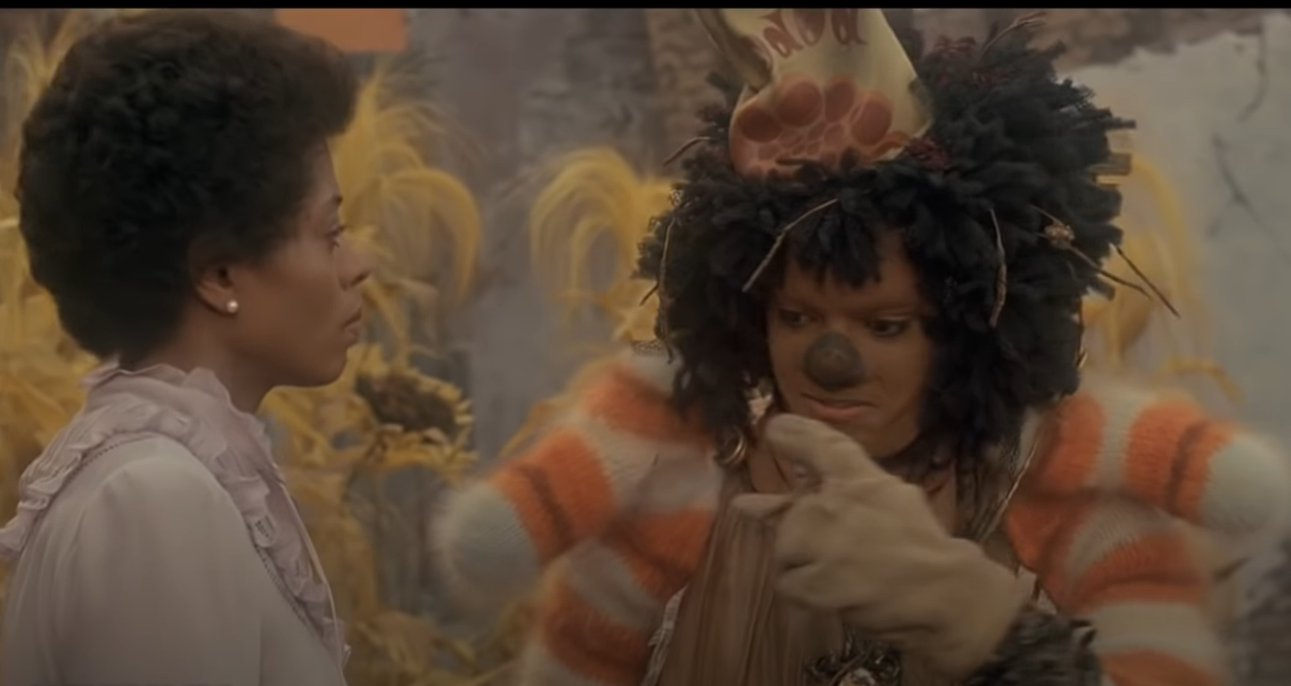
Or education. Dorothy is a twenty-four-year old Harlem schoolteacher who helps the Scarecrow escape and invites him to see the Wizard with her. This prompts the Scarecrow to respond, “You mean all this time the only thing standing between hanging up there and living it up down here were those crows? If I only had a brain. I would’ve figured that out a long time ago.”
Fortunately, he has Dorothy to think for him. She’s polished, confident, and mature. Her heels (silver, not ruby here, to match the Frank L. Baum novel) don’t look as out of place with her formal businesswear as Judy Garland’s glittery pumps did with her farmgirl gingham. Actress Diana Ross was thirty-four when the movie debuted, a decade older than her character is supposed to be and fourteen years Michael Jackson’s senior. She personifies progress, education lifting black people out of the Jim Crow era. What she doesn’t do is look young or vulnerable.
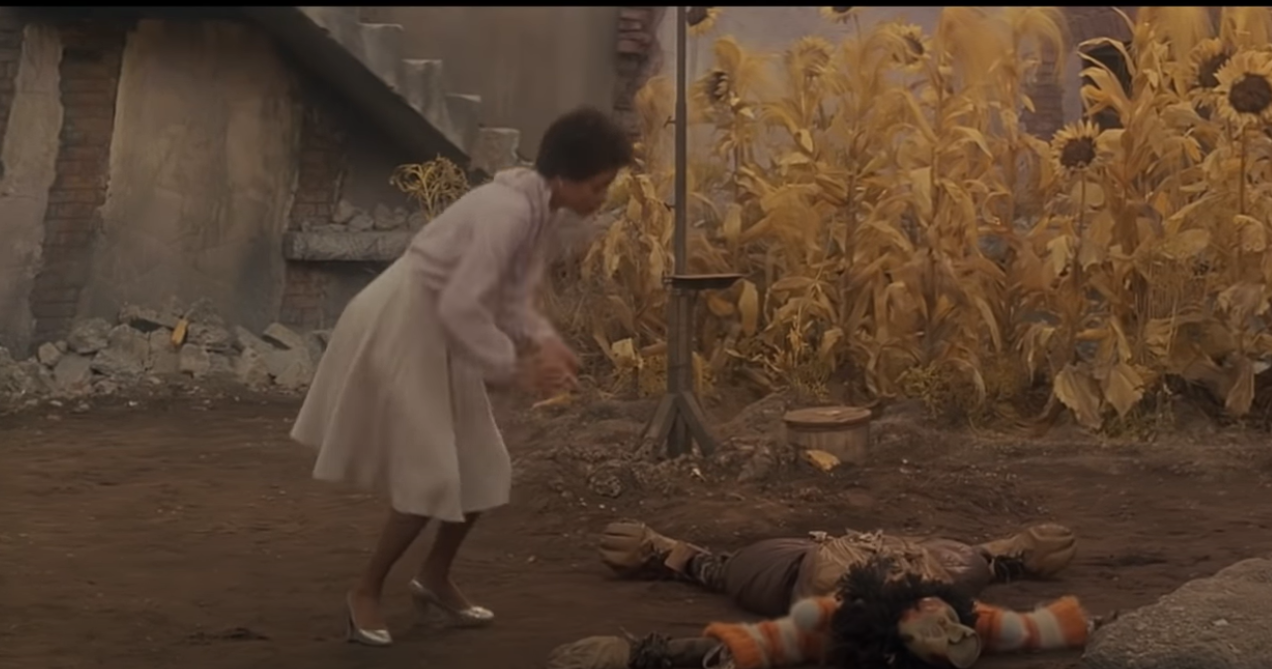
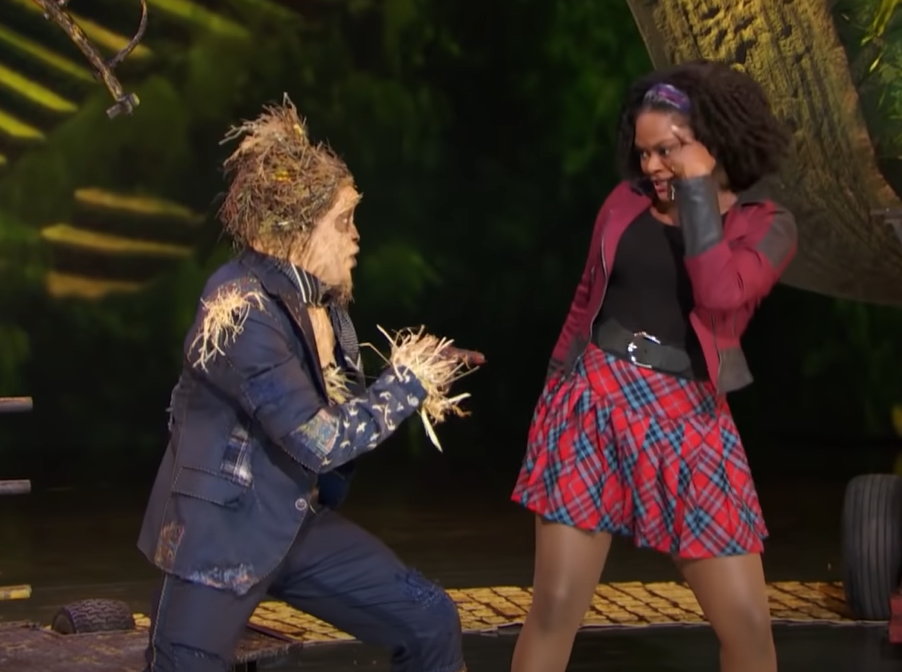
That was a fitting message for the seventies, but by 2015, black America was more distanced from Jim Crow and young black people were affected by other challenges. Among them, fractured families.
Kenny Leon, director of the 2015 televised special the Wiz Live! Stated in an interview, “there are so many [children], especially kids of color, who live in foster homes or live with their uncles or with their aunts.” Dorothy living with her extended family is an element that was present in the original Baum text and countless adaptations, but here, it is presented “specifically from an African-American point of view.” Instead of getting kidnapped by the tornado, writer Harvey Fierstein imagines her as “more of a stubborn runaway, who wishes the whole thing upon herself.” She resents having to live with her aunt and uncle until her adventure away teaches her the magic of home.
Fittingly, this new Dorothy is much younger than the Harlem schoolteacher of the original. Shanice Williams is nineteen, sweet, and sassy, portraying Dorothy in a plaid skirt reminiscent of school uniforms paired with a red leather jacket for a dash of youthful rebellion. The casting and costuming updates the character to give off a younger vibe and address a social issue more pertinent to the current rising generation.
Many Cinderella retellings and other royal wedding tales focus in on the soap operatic elements of marrying a prince. In the musical The Slipper and the Rose (currently accessible on Amazon Prime), the prince is actually treated as the bonafide politician and dynasty member he is. Prince Edward’s declination of his elderly, toothless arranged-marriage bride sparks a war from their would-be ally. Marrying a common girl is a no-go when he has a country to think of. Cinderella’s scullery-and-stepfamily side of the plot is the same as most adaptations, but the prince’s side of the story is trimmed with protocol and political pressure.
It’s one of those “they don’t make them like they use to” musicals, elaborately costumed and choreographed, and funny. Edward and Cinderella first encounter each other when a sad Cinderella visits her parents’ grave (an action that will later incur her stepmother’s wrath). Prince Edward and his manservant buddy John frolic in the nearby royal crypt. He poses on his ancestors’ tombs and jumps from grave to grave, singing about how comforting it is to know that no matter how he fails his kingdom, he’ll lie in company with every good and bad king from his family line. It’s a rolicking, sardonic number, with some splendid athleticism from John, played by Christopher Gable, a dancer with the royal ballet. That kind of dancing is hard to achieve night after night in a stage production, but here it’s crystallized in time forty-five years out from filming.
This is followed by a stuffy, mincing, hilarious number called “Protocoligorically Correct,” where the royal ministers of state sing about the necessity of matching the prince to a princess who could lend military aid in the pending war. Later on, the most splendidly choreographed number is “Position and Positioning,” where acrobatic servants dance through their chores, singing:
Though you work your life away,
Where you start is where you stay,
Which means there’s nothing changeable,
Nothing’s rearrangable;
Position and positioning are stuck with you for life!
Edward’s servant John is unable to marry his beloved Lady Caroline because of his rank. Likewise, Edward feels confined by his duty to marry a princess.
Fleshing out the prince’s side of the story is refreshing. It’s also long. Two hours and twenty three minutes on Amazon prime. Position and Positioning alone runs for a full eight minutes. Cinderella arrives at the ball at the halfway point and the political implications of her doing so take up another hour. So when NBC broadcast it in 1981, five years after its VHS release, they trimmed sixteen minutes off. Cinderella is introduced at the ball as “the Princess Incognito,” leading the prince to believe he can satisfy both his heart and his duty.
But alas, scullery maids can’t offer a man armies and navies. The Stepmother gives her permission for Cinderella to get married, but the powers-that-be don’t, and Cinderella willingly goes into exile when she learns that their romance threatens the nation. She only is able to make a comeback when the prince’s socially awkward cousin bails him out by falling in love at first sight with the prince’s intended bride, allowing the alliance to go on.
Theater is an ephemeral art. To some extent, television is, too. The Wiz has only aired on television twice-with the initial premiere in 2015 and as a special feature during the wave of promotion of black arts and culture in the summer of 2020. Broadcasting musicals comes with a loss, certainly. Elaborate dancing or ice skating that would be gloriously entertaining in person can come off as cheesy with a screen creating distance. But televised musicals also have the power to redefine a character or story for a broader audience and lure home-based audiences into the theater to experience the real thing.
Running time might get chopped down, either to clear out certain content or to accommodate commercial breaks, though this is gradually becoming less common on subscription-based streaming services. Eventually, everything has or will make its way online, freezing a version of your favorite live musicals in time and place to be experienced again and again, making entertainment more accessible for all.